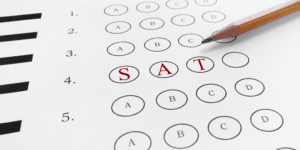Imagine that your child is running on the playground and hurts an ankle.
As a parent, you may not know at first whether it’s a sprain or a fracture — but either way, you can see that your child is having difficulty walking. While both injuries may require rest, the type of specific treatment will vary based on the injury.
Parents of children with Attention Deficit Hyperactivity Disorder (ADHD) and Specific Learning Disabilities (SLD) face an analogous situation. They must learn which learning difficulties their children face so they can ensure that the special education team develops an effective treatment plan or individualized education program (IEP) to address the intellectual disability and support the cognitive, academic, and social growth of their kids.
The Relationship Between ADHD and SLD (Specific Learning Disability)
When a child is first diagnosed with ADHD or SLD, the importance of the exact terms and acronyms that professionals use may be unclear to parents.
For starters, ADHD is not technically considered a learning disability. The U.S. Department of Education defines Specific Learning Disabilities as disorders affecting psychological processes that compromise a student’s ability to “listen, think, speak, read, write, spell, or to do mathematical calculations,” while ADHD falls into the category of “other health impairment,” characterized by “limited strength, vitality, or alertness, including a heightened alertness to environmental stimuli, that results in limited alertness with respect to the educational environment.”
The symptoms of ADHD and SLD can look similar, depending on the type of specific learning disability a child has because both can play a role in intellectual ability. A further confounding factor is that many students’ learning difficulties are a result of both ADHD and SLD. Indeed, according to the Learning Disabilities Association of America, between 30 and 50 percent of kids with ADHD have an SLD, too. The LDAA goes on to say that “the two conditions can interact to make learning extremely challenging.” When the two conditions interact, students may experience learning difficulties when it comes to basic reading skills, reading comprehension, listening comprehension, oral expression, and math problems (mathematical calculations).
It’s not uncommon for parents to be confused about the appropriateness of particular special education services for children with such conditions (either ADHD or SLD). While each of type of learning disorder or difference can affect a child’s academic growth, various disorders have distinct sets of underlying causes and require appropriately tailored intervention plans and IEPs (individualized education program).
The Role of Neurology
The neurological areas affected in students with ADHD and SLD differ in important ways. To read successfully, for example, people typically use three primary sections of their brains, all of which are located in the left hemisphere: the inferior frontal gyrus (also known as Broca’s area), which is responsible for producing speech; the more posterior temporoparietal area; and the occipitotemporal region. The last two are both active in recognizing and understanding spoken and written language.
Imaging studies on individuals diagnosed with dyslexia — one specific learning disability affecting students’ academic skills such as reading comprehension and writing abilities — suggest that the distinctive characteristics of this learning disorder are an underactivation in the temporoparietal and occipital regions, and an overactivation in the front left and right hemispheres. This understanding of the precise brain activity involved in dyslexia helps to account for the difficulties with spelling, word recognition, and reading pace that children with this disability experience.
By comparison, studies conducted on individuals with ADHD show variations in the sizes of four regions of the brain — the corpus callosum, the basal ganglia, the frontal lobes, and the cerebellar vermis — as compared with the brains of those who do not have this disability. These neurological structures are involved in “thinking, paying attention, and planning,” according to the National Institutes of Health][2]{: target=”_blank” }. While the causes of ADHD are not yet fully understood, researchers and neurologists know that these areas of the brain are involved in impulsivity, focus, and [problem-solving. In other words, whereas the neural circuitry involved in reading, writing, and numeracy is implicated in individuals with SLD (specific learning disability), the reward and decision-making pathways in the brains are affected in individuals with ADHD. As a result, the symptoms of ADHD tend to be behavioral rather than skills-based.
The Role of Interventions
Given the underlying neurological differences between students with ADHD and those with SLD, treatment approaches will necessarily vary based on the student’s response to intervention. Medication has been shown to be an effective component of a management plan for 70–90 percent of people with ADHD. Behavioral plans based on establishing clear goals (such as, “I will put my homework in my backpack.”), measuring progress, and providing rewards for accomplishments can be included in IEPs (individualized education programs) to provide additional support.
By contrast, there is no medication that has been proven to work for students with a specific learning disability (SLD). Similarly, behavioral plans are not effective for someone with a learning problem like a reading disability, for example, since the impairment lies in precise areas of the brain in which written and spoken language are processed.
Students with SLD such as dyslexia, dysgraphia, and dyscalculia benefit from working with a trained reading specialist or special education teacher to instruct them on the structure of language and the mechanics of reading comprehension, writing, and math problems and mathematical calculations.
There are, however, some commonalities between ADHD and literacy-related SLD. For instance, both of these may result in difficulty with reading comprehension skills. According to research][5] from [Johns Hopkins University (JHU), the attentional demands of fluent literacy may cause students with ADHD to experience slower processing speed, less reading fluency, and an inability to multitask while reading. The JHU experts suggest that “children with ADHD can benefit from separating writing and listening activities.” Specifically, the researchers advise educators to “reduce the demands for multitasking, speeded performance, and simultaneous writing and listening” whenever possible — educational approaches that may also benefit those with SLD. So, while students with ADHD are not contending with the localized neurological differences that children with SLD experience, their academic skills and growth can be similarly affected.
Students with ADHD as well as those with a specific learning disability SLD may benefit from assistive technology, though not necessarily from the same tools. For example, while both types of learners may be helped by text-to-speech tools, many students with ADHD need to doodle or write notes as they listen.
Learners with ADHD and SLD can also get support from speech-to-text (or dictation) tools, but the former are more likely to use these as brainstorming platforms (perhaps even pacing around or fidgeting while dictating in order to generate ideas and promote). Students with SLD, by contrast, often use such software throughout the entire writing process because dictation can also support their spelling and writing fluency.
The Role of Legal Mandates
Students who receive specialized instruction at K–12 public schools typically fall into one of several special education categories that align with different diagnoses, such as autism, deafness or hearing impairment.
Children with SLD will typically be evaluated for an Individualized Education Program][3] (IEP) by a [special education team of teachers, administrators, learning specialists, a school psychologist, the child, and the caregiver(s). The plan that emerges is designed to provide the student with targeted services and curricular modifications to support her educational, behavioral, and physical development. For example, a child who is diagnosed with autism spectrum disorder may be provided with modified assignments by her classroom teacher within a general education classroom and social skills training by a speech-language therapist, a range of supports that align with that student’s needs and learning goals.
By contrast, an ADHD diagnosis is made by a neurologist, pediatrician, psychologist, or psychiatrist, and falls within the category of “other health impairment.” (Other health impairments include conditions like asthma, epilepsy, diabetes, and Tourette syndrome.) Since ADHD is more accurately described as a difficulty of alertness — specifically “heightened alertness to environmental stimuli” — the impact that it has on students’ decision-making and attention affects the development of skills across academic subjects and other areas of a child’s life, such as executive functions and organizational skills. Consequently, students who struggle solely with ADHD (but not concomitant SLD) may not be given an IEP, which is designed to provide highly targeted related services to address the discrete challenges of specific disabilities. Rather, these students will receive a 504 plan][4] to provide them with educational [accommodations that are applicable across learning areas (like extra time on exams or separate testing rooms with fewer distractions).
Students with ADHD may not need as many in-school supports as learners with SLD. For example, a child with ADHD may have a 504 plan that includes appropriate medication along with support from an external organizational skills training specialist or psychologist. But otherwise, that student may only require extra time on tests and assignments to compensate for a slower processing rate. By contrast, students with SLD need specific, focused goals that align with the precise disability and its related academic areas, as well as explicit, evidence-based instruction and appropriate services.
The Significance of Classification
Ultimately, ADHD and SLD classifications are important for educational purposes to ensure that children are able to succeed at school and at home. If ADHD is incorrectly classified as a Specific Learning Disability, students with the disorder may only receive supports in reading, writing, or math instruction — despite the fact that ADHD has an impact on all of these academic areas (as well as on a child’s social skills). Effective supports will address academic and attentional challenges for these learners, just as interventions for a child with a reading or math disability need to be tied specifically to the literacy or numeracy skills with which that student struggles.
Use the free Noodle search tool to learn more about schools that match your needs. Register for a Noodle account to ask Experts like Jules Csillag questions about your child’s educational needs.
Sources:
Lanir, L. (2011, November 27). Neurological causes of ADHD: Basal ganglia studies. Retrieved November 13, 2015, from Decoded Science.
Limb, C., & Braun, A. (2008). Neural substrates of spontaneous musical performance: An fMRI study of jazz improvisation. PLoS ONE. Retrieved November 13, 2015, from Plos One.
Liu, S., & Chow, H., et al. (2012, November 15). Neural Correlates of Lyrical Improvisation: An fMRI Study of Freestyle Rap. Retrieved November 13, 2015, from Nature.
Mahone, E. (2012). The effects of ADHD (beyond decoding accuracy) on reading fluency and comprehension. Retrieved November 13, 2015, from Johns Hopkins School of Education.
Office of Special Education and Rehabilitative Services Blog. (n.d.). Retrieved November 13, 2015, from U.S. Department of Education.
Shaywitz, S. E. (2003). Overcoming Dyslexia. New York: Vintage Books.White, H., & Shah, P. (2011). Creative style and achievement in adults with attention deficit hyperactivity disorder. PsycEXTRA Dataset, 50(5), 673–677. Retrieved November 13, 2015, from Science Direct.




